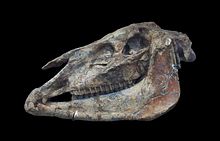fiction.wikisort.org - Writer
Johann Andreas Wagner (21 March 1797 – 17 December 1861) was a German palaeontologist, zoologist and archaeologist who wrote several important works on palaeontology.
Johann Andreas Wagner | |
|---|---|
| Born | 21 March 1797 Nuremberg |
| Died | 17 December 1861 |
| Occupation | |
| Academic career | |


Career
Wagner was a professor at the University of Munich, and curator of the Zoologische Staatssammlung (State Zoology Collection). He was the author of Die Geographische Verbreitung der Säugethiere Dargestellt (1844–46).
Wagner was a Christian creationist.[1]
Pikermi
In his travels to the fossil beds of Pikermi, Wagner discovered and described fossil remains of mastodon, Dinotherium, Hipparion, two species of giraffe, antelope and others.[2][3] His collaboration with Johannes Roth on these fossils became a major textbook in palaeontology, known as "Roth & Wagner", in which the "bones were much broken, and no complete skeleton was found with all the parts united".[4][5]
Legacy
Wagner is commemorated in the scientific name of a species of South American snake, Diaphorolepis wagneri.[6]
Bibliography
- (in German) 1844-1846. Die Geographische Verbreitung der Säugethiere Dargestellt.
- (in German) Johann Andreas Wagner 1897. Monographie der gattung Pomatias Studer.
References
- Rupke, Nicolaas A. (2005). Neither Creation nor Evolution: The Third Way in Mid-Nineteenth-Century Thinking about the Origin of Species. Annals of the History and Philosophy of Biology 10: 160.
- Upper Miocene Formations of Greece at Pikermi Archived 2012-06-03 at the Wayback Machine on Geology.com
- Neue Beiträge zur Kenntniss der fossilen Säugthier-Überreste von Pikermi on Google books, by Wagner, Munich, 1857
- Die fossilen Knochenüberreste von Pikermi in Griechenland on Google books, by Johannes Rudolf Roth and Johann Andreas Wagner, Munich, 1854
- "bones were much broken" in the Edinburgh New Philosophical Journal, Volume 6, 1857, page 182
- Beolens, Bo; Watkins, Michael; Grayson, Michael (2011). The Eponym Dictionary of Reptiles. Baltimore: Johns Hopkins University Press. xiii + 296 pp. ISBN 978-1-4214-0135-5. ("Wagner, J.A.", p. 278).
На других языках
- [en] Johann Andreas Wagner
[ru] Вагнер, Иоганн Андреас
И́оганн А́ндреас Ва́гнер (нем. Johann Andreas Wagner; 21 марта 1797 (1797-03-21), Нюрнберг — 17 декабря 1861, Мюнхен) — немецкий палеонтолог, зоолог и археолог. Вагнер был профессором зоологии в Мюнхенском университете и куратором государственного зоологического собрания. 3 декабря 1855 года был избран членом-корреспондентом Петербургской академии наук[1].Другой контент может иметь иную лицензию. Перед использованием материалов сайта WikiSort.org внимательно изучите правила лицензирования конкретных элементов наполнения сайта.
WikiSort.org - проект по пересортировке и дополнению контента Википедии